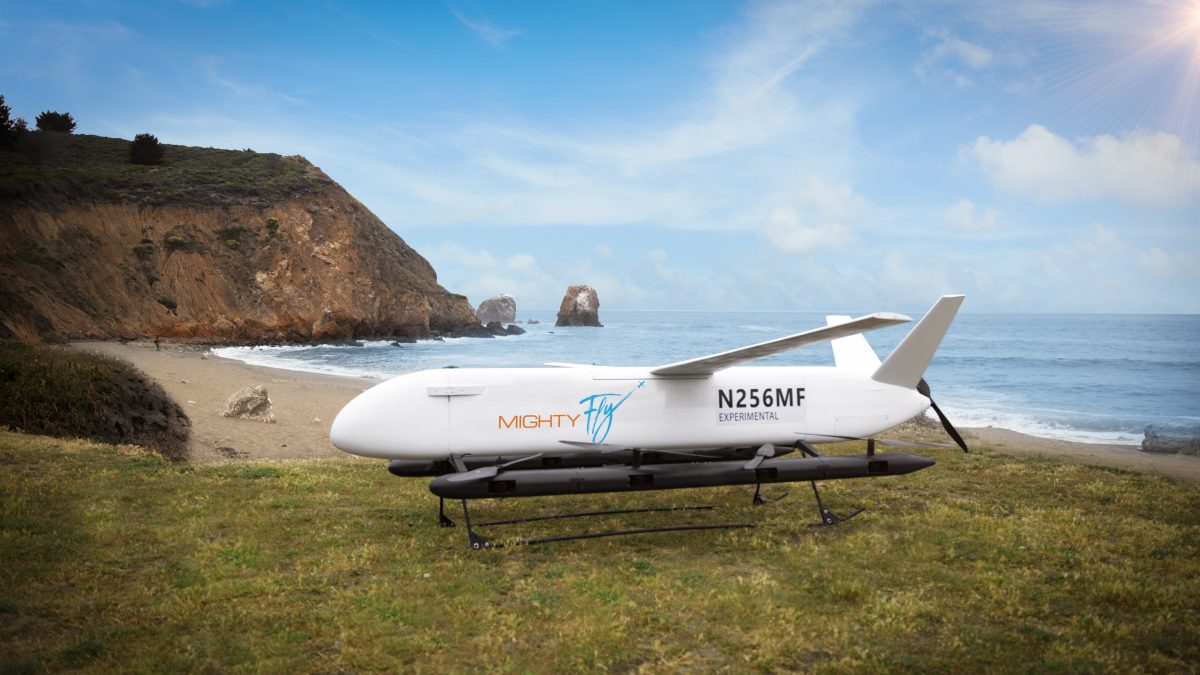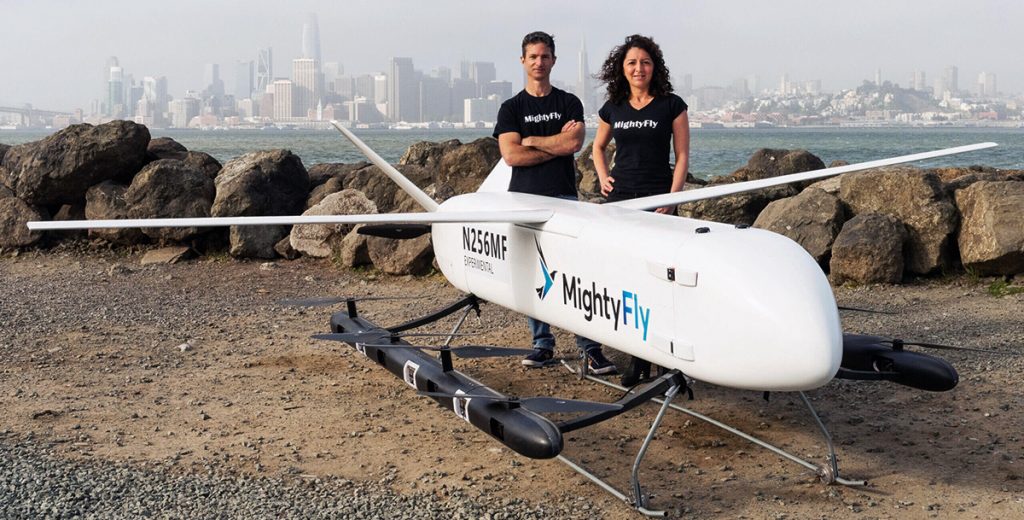
Five years from now, the shoes or iPhone you just ordered online might be delivered to you in just a few hours. How is that possible? Hybrid-electric, vertical take-off and landing (VTOL) autonomous aircraft – that’s how.
VTOLs are a type of drone about the size of an average car that takes off and lands vertically like a helicopter – no runway needed. An autonomous aircraft flies under the control of automatic systems and needs no intervention from a human pilot. Though at the moment, autonomous aircrafts are flying under the supervision of remote pilots.
It’s the vision of entrepreneur, aerospace engineer and pilot Manal Habib. In 2019 she co-founded MightyFly, a start-up hoping to disrupt logistics with new-generation VTOL air units called the MightyFly MF-100.

Delivery by drone isn’t a new idea. Amazon is working on its Prime Air service that autonomously flies packages to customers by delivery drones in 30 minutes or less. UPS’s drone airline, Flight Forward, recently received a Federal Aviation Administration certification, removing limits on how frequently and widely the multinational logistics company can operate.
Habib says the MightyFly MF-100 is unique because it automates loading and unloading as well as flight. “It can make many deliveries in the same flight. We’ll keep the economies of scale and flexibility delivery vans give, but by automating the system and moving it to near-empty airspace, we’ll see a cheaper, more efficient and faster service.”
Small but mighty
The MightyFly MF-100 has a cargo capacity of 100 pounds (45 kg) – that’s double the maximum checked bag weight on most airlines – cruises at 150 mph (240 kph) and has a range of 600 miles (nearly 965 km.)
Habib designed the craft with MightyFly co-founder Scott Parker, a product manager and mechanical engineer. The pair met while working at drone delivery company Zipline.
MF-100 uses nine electric motors to take off, then runs on gas once it transitions to fixed-wing flight. In future, the company will look at cleaner alternatives to gas like hydrogen fuel cells, and develop a craft capable of carrying five times the weight.
MightyFly MF-100 taking off and in fixed-wing flight
Habib says skies full of hybrid-electric autonomous planes is what the huge – worth an estimated 8 to 12 trillion US dollars globally – and “stagnant” logistics industry needs.
Changes in customer expectations and industry norms
COVID-19 increased the need for faster delivery/ People isolated at home needed goods to arrive fast. Trucks – the predominant method of delivery – are expensive and slow. Autonomous hybrid aircraft will change this.
Manal Habib, aerospace engineer, pilot and MightyFly co-founder
Will fleets of hybrid-electric ghost planes replace trucks as the delivery’s dominant vehicle? Stan Caldwell, Carnegie Mellon University’s Adjunct Associate Professor of Transportation and Public Policy, thinks it’s feasible. “We’re seeing rapid increase in serious consideration of drones for freight delivery, especially last-mile freight,” he says. ‘Last mile’ is the part of a delivery process that reaches the consumer – normally from a distribution center. Some of the world’s biggest retailers and logistics companies – like Google, UPS and DHL – are already experimenting with drone delivery.
Caldwell thinks delivery systems are becoming less centralized through a few companies, aiding the drone logistics boom. There are many players on the market. “Distribution of systems is a trend in the freight industry. Walmart has delivery drones, and next, your local independent grocery store gets its own.”
Taking the good with the bad
Having systems more spread out and drone-reliant comes with benefits. When electric vehicles replace those with internal combustion engines, you reduce carbon emissions and air pollution. In the US, trucks produce about 29 percent of total greenhouse gas emissions – the country’s largest contributor. There’s also less congestion. “Drones can’t cause a bottleneck at the port,” says Caldwell.
But Caldwell also urges, before we foresee drone armadas fetching items at supersonic speed, we update (or revise) regulation. The Federal Aviation Administration (FAA) regulates commercial air traffic in the US, but drones are a different beast. Drone delivery may need local regulation: Different laws in different cities.
“In the same way you see signs saying “No trucks allowed on this road or business district,” cities should be able to regulate drones,” says Caldwell.
In July 2021, there were 858 drone start-ups in the US alone.
The future of VTOLs may need much local regulatory thinking. How will port, pickup and drop-off locations interface with the ground? Will we need strategically placed small warehouses drones can fly in and out of? There are many such questions, says Caldwell.
For Hunter Kosar, owner and president of US shipping and trucking company Twisted Nail Broker Services, the idea ventures like MightyFly might replace trucking is “a bit of a stretch.” Kosar struggles to imagine businesses that need to rapidly send under 500 pounds of freight at 150 mph within a 300-mile radius. “VTOLs will make the 600-mile round trip in four hours, but a big rig 18-wheeler truck will do the same trip in 12 hours carrying 90 times the freight.”
Kosar sees a VTOL niche in transporting time-sensitive supplies like human organs between hospitals. “Organs are light, expensive and needed fast. Healthcare would pay a lot to receive a heart for transport in 90 minutes instead of 4 hours.”
He thinks to disrupt the traditional freight industry, the craft’s loading capacity would need to increase by 75 times, and they’d need local and regional permits to operate in any area’s airspace. It seems unlikely to him, at least in the near future.
Autonomous aircraft and trucks sharing the load
MightyFly’s last round of funding raised 5.1 million US dollars in just two months. “We’ll use this funding to hire people, scale up our fleet and build the infrastructure to support a global network of hubs,” says Habib. But if VTOL units conquer the skies and dot the lands with small, scattered distribution centers, trucks may not be doomed to extinction.
“It will need human-intensive management. Trucks could go out to certain neighborhoods, then drones take the goods from the trucks and deliver them to individual houses. We’ll need people to manage that system,” Caldwell says, although he thinks drones will also redefine those people’s roles.
The big question when it comes to lightweight, last-mile delivery is not whether the technology is too futuristic – it’s already here. Experts stress we’ll need tailor-made regulation to govern drone traffic area-by-area and ways for drones to interface with final destinations.
Before galloping away with the latest technological sensation, business leaders might consider that technology usually outpaces law. Even simple things like where the drone will leave your package – the mailbox, under the porch, inside or outside? – haven’t yet been sorted. “You can’t imagine the amount of human judgment that goes into where the delivery person leaves packages,” says Caldwell.




